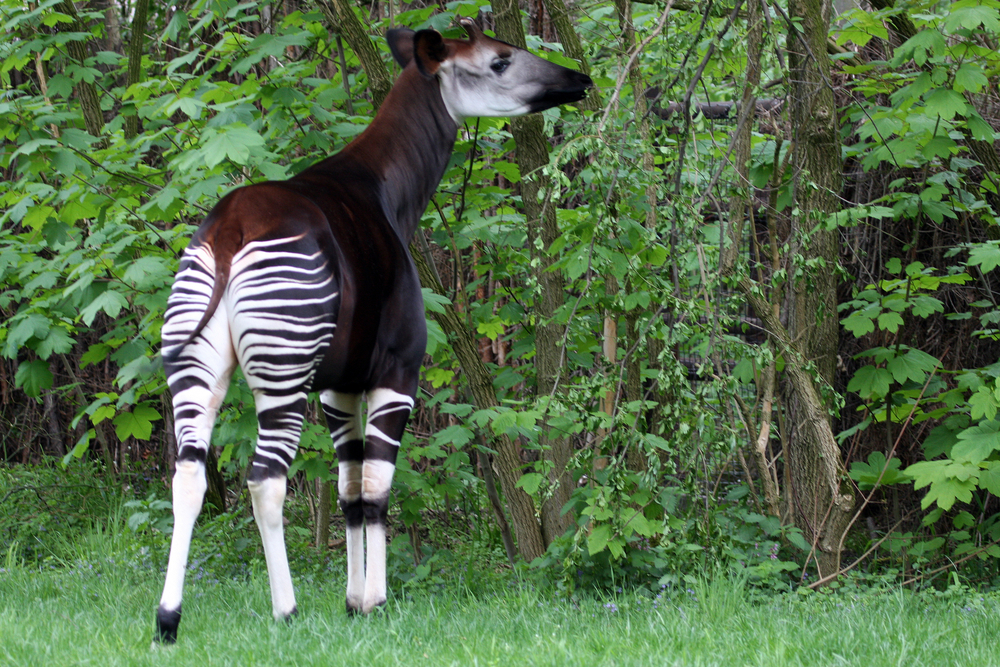
Like a character dreamt up for a Dr Doolittle spin-off film by an over-caffeinated CGI artist, the okapi resembles the result of a drunken night of ill-advised passion between a zebra and a giraffe. Yet this idiosyncratic animal’s predicament is anything but amusing. The rare and intriguing mammal from the deepest darkest forests of the Democratic Republic of Congo (DRC) in Central Africa, is staring extinction in the face, unless a new plan released this month can save its strange semi-striped hide.
The only other living member of the giraffe family, okapis are considerably shorter than their lofty long-necked near-cousins, with the average animal standing around 1.5 metres tall. Like giraffes they’re herbivores and lead a peaceful existence, but these gentle beasts have fallen victim to some shocking acts of violence in recent years, including an attack on the Okapi Wildlife Reserve headquarters in the DRC in 2012 that ended in the deaths of all 14 okapi housed within the facility, plus seven people.
The International Union for Conservation of Nature (IUCN) lost one of their rangers in that dreadful attack, and they—along with partners Institut Congolais pour la Conservation de la Nature (ICCN) and the Zoological Society of London (ZSL)—are behind the newly hatched 10-year plan designed to ensure the species’ survival.
Sometimes known as ‘forest giraffes’, there are somewhere between 10,000 and 50,000 okapis knocking around in the wild, but definite figures for such a shy animal are impossible to source; suffice to say, they are classified as ‘Endangered’ on the IUCN Red List of Threatened Species. The animals are bearing the brunt of horrendous habitat loss, poaching (for bushmeat), armed conflict and now the rapacious pursuit of land and resources from gold and diamond mining freelancers and oil extraction industries.
The future safeguarding of the World Heritage-listed Okapi Wildlife Reserve is the foundation stone of the plan, especially after an influx of thousands of illegal gold miners into land within the reserve. Besides protecting the dwindling okapi population from poachers and prospectors, a major objective of the strategy is to discover more about what the ZSL’s Dr Noëlle Kümpel describes as ‘an iconic species for DRC and the wider world.’
‘There are still enormous gaps in our knowledge of these creatures, in large part because security concerns across their range has prevented survey teams getting on the ground,’ said Dr Kümpel, co-chair of the IUCN SSC Giraffe & Okapi Specialist Group. ‘But what is clear is the unprecedented pressure and range of threats now facing these rare and amazing animals. This global strategy provides a clear roadmap for joint action to bring them back from the brink of extinction, tackling these wider threats so we can focus on specific actions to better manage and monitor okapi, such as implementing SMART [Spatial Monitoring and Reporting Tool] technology.’
Okapi are also found in the DRC’s Virunga National Park, the most biodiverse protected area in Africa, which, despite its own World Heritage listing and a 2015 European Parliament resolution, is still being menaced by industrial-scale oil exploration. On 21 January 2016, a joint statement signed by 60 influential people and organisations was released, urging UNESCO and the governments of Uganda and the DRC to agree to stop new oil drilling licenses being awarded in and around the Virunga World Heritage site region.
The future of this awesome ungulate could yet depend on their response.

